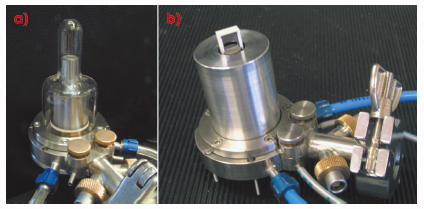- Home
- Users & Science
- Scientific Documentation
- ESRF Highlights
- ESRF Highlights 2009
- Enabling Technologies
- Sample environment: development of customised microfurnaces
Sample environment: development of customised microfurnaces
Over the last ten years the Sample Environment Support Service has developed a series of microfurnaces for use on the X-ray beamlines. The philosophy of the design has always been to construct a general base with a very large optical access to the sample, and adapt the furnaces to different experiments. The integration of X-ray instruments in a very small space on the beamline is often difficult, in particular for heating systems. The detector must be as close as possible to the sample; the volume of the chamber has to be just a few cm3. Both the chamber and heater material have to be compatible with a corrosive atmosphere; the compatibility with oxygen is often demanded. The thermal load on the environment must be kept very low, so the thermal insulation of the heating element has to be optimised keeping the input of the electrical power low while the spatial stability of the sample positioning has to be maintained.
The first generation of micro-furnaces was built for the X-ray imaging beamline ID19. This microtomography furnace (Figure 150a), covering the temperature range from room temperature to 1000°C, has been designed to study the structural evolution of materials in situ by using synchrotron X-ray microtomography [1]. The furnace has cylindrical symmetry compatible with the required 180° rotation, small dimensions and low absorption. The quartz dome pictured in Figure 150a can easily be replaced by a cap with any other type and shape of window. This generation of furnace has demonstrated a high level of temperature stability and adaptability to the sample shape. One of the recent developments has been an open configuration in air for diffraction tomography experiments (see Figure 150b) on BM05 and ID19. In this case the sample is held in a boron nitride frame, between two silicon plates to optimise the thermal transfer to the sample.
This setup was also modified for use as a gas-flow catalysis cell because of its large diffraction angle which permitted the use of the turbo-XAS method on the dispersive EXAFS beamline ID24 [2]. For this new application, temperatures above the maximum temperature supported by the heater material were required, and so a new heater material had to be found. One of the few suitable candidates appeared to be Maxthal 211 (Ti2AlC). This material possesses a combination of properties essential for high-temperature non-stick coating applications. It is remarkably resistant to thermal shock, wear, oxidation and corrosion; it is tough and a good electrical and thermal conductor. Our unique solution was to spot weld two stainless steel electrical connectors onto the heater disk. This permits the passage of strong currents through the system, and avoids problems encountered in the past, such as oxidation of the cell elements and electrical connection failure, that could require intervention during an experiment.
 |
|
Fig. 150: a) Microtomography furnace 180° rotation. b) Customised microtomography furnace for diffraction tomography. |
Both gas-flow catalysis cells have been developed to work in fluorescence mode for in situ and dynamic X-ray absorption experiments on chemical systems. The compact design of the cells and the versatility of the different components of the setup (reactor cell and cooled silicon diode) permit fine-tuning the system so that the optimal geometrical conditions can be attained. Time-resolved studies were done on low-loaded heterogeneous catalysts under catalytic gas-flow conditions (O2/H2 cycles), reaching temperatures up to 850°C with an accuracy of +/-5°C. This unique set of experiments has opened new horizons for car manufacturers in the development of novel catalytic exhaust converters.
This development allowed the introduction of a novel generation of furnaces aiming at higher temperatures up to 1200°C and high heating speed (see Figure 151). One of the main characteristics of this furnace is the miniaturisation; its diameter of 65 mm and height of 60 mm permits the furnace to be mounted on a miniature Huber 1003-MG gonimeter head. The second main characteristic is the high speed of heating and especially the possibility of cool down/quenching at 10°C/second. With this low thermal inertia, the temperature stabilisation stays at ± 0.5°C. The number of parts is kept to a minimum to guarantee good mechanical stability of the sample position. The latest furnace was designed for ID01 for use in a study on CdS nanocluster annealing. Two different techniques, grazing-incidence small-angle scattering and grazing incidence diffraction were used to study the variation of the morphology of the system and the formation of the crystal structure.
 |
|
Fig. 151 : Maxthal furnace for thermal annealing experiments. |
All of the new microfurnaces have been added to the sample environment loan pool resulting in a suite of 18 different furnaces that are available for use at the ESRF beamlines. They can be requested by users and are reserved by beamline staff through the intranet sample environment loan pool application.
References
[1] D. Bellet et al. J.Appl. Cryst. 36, 366-367 (2003).
[2] G. Guilera, et al. J. Synchrotron Rad. 16, 628-634 (2009).
Authors
B Gorges, P van der Linden and H. Vitoux.
ESRF



